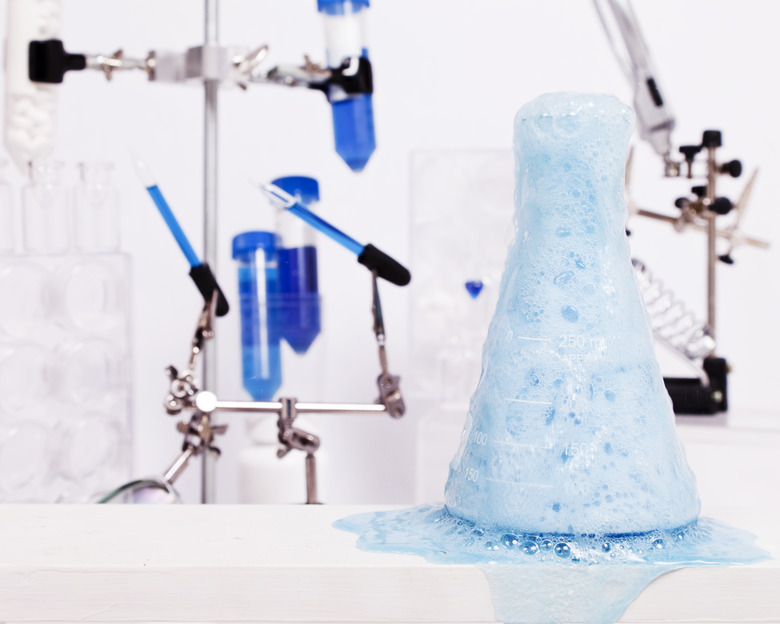What Do Calcium Chloride & Baking Soda Make?
Combining calcium chloride and baking soda — sodium bicarbonate — in a sealable plastic bag is a favorite high school chemistry experiment. It produces a gas, so if you seal the bag after combining the chemicals, the bag will blow up like a balloon. Another reason high school chemistry teachers love this experiment is that the combination produces heat, so it's an excellent example of an exothermic reaction. Wear goggles and rubber gloves when combining these two compounds, because one of the byproducts of the reaction is hydrochloric acid, which is corrosive enough to burn your skin.
TL;DR (Too Long; Didn't Read)
Combine sodium bicarbonate (baking soda), calcium chloride and water and you get calcium carbonate (a chalky precipitate) plus carbon dioxide gas, sodium chloride (table salt), hydrochloric acid and a fair amount of heat.
What Are the Reactants?
Virtually everyone is familiar with sodium bicarbonate (NaHCO3), because it's the baking soda you use to deodorize your refrigerator. Fewer people are familiar with calcium chloride (CaCl2), but they should be. Like sodium chloride, it's a salt, and it's hygroscopic, which means it absorbs moisture from the air. Putting a dish of calcium chloride in your closet is a good way to protect your clothes from mold. Calcium chloride helps dust control and works as a food additive, because it can make foods like pickles taste salty without actually adding sodium chloride.
A Two-Part Reaction
The reaction between sodium bicarbonate and calcium chloride must occur in solution, so water is always a part of the reaction. Both reactants dissolve readily in water, so that isn't a problem. You can dissolve one in water then add the other, or you can keep both in opposite corners of a plastic bag and place a vial of water between them so that, when you shake the bag, they combine with the water and each other.
When you combine the reactants, two things occur. The first thing is that they combine to form calcium carbonate — a compound found in limestone, chalk, marble and the shells of snails and sea creatures — along with sodium chloride and hydrogen ions. The hydrogen ions turn the solution acidic, and they combine with leftover sodium bicarbonate to produce carbon dioxide gas, water and sodium ions. They also combine with chlorine to make hydrogen chloride.
The release of carbon dioxide gas blows up the bag, and because the gas is produced in an exothermic reaction, the temperature of the solution goes up.
The Chemical Equations
In the first reaction, the reactants combine to form calcium carbonate, sodium chloride and hydrogen ions. The equation for this reaction is:
**CaCl2 + 2 NaHCO3 —> CaCO3 + 2 NaCl + H+**
The hydrogen ions then combine with unused sodium bicarbonate to form carbon dioxide, water and sodium ions.
**H+ + NaHCO3 —> CO2 + H2O + Na+**
Sodium chloride dissociates into Cl- and Na+ ions in water. Some of the free chlorine ions combine with hydrogen ions to form hydrogen chloride.
**H+ + Cl- —> HCl**
A simplified equation for the overall process is:
**NaHCO3(s) + CaCl2(s) + H2O(l) —> CaCO3(s) + CO2(g) + NaCl(aq) + HCl(aq)**
Cite This Article
MLA
Deziel, Chris. "What Do Calcium Chloride & Baking Soda Make?" sciencing.com, https://www.sciencing.com/do-amp-baking-soda-make-5498056/. 11 April 2018.
APA
Deziel, Chris. (2018, April 11). What Do Calcium Chloride & Baking Soda Make?. sciencing.com. Retrieved from https://www.sciencing.com/do-amp-baking-soda-make-5498056/
Chicago
Deziel, Chris. What Do Calcium Chloride & Baking Soda Make? last modified August 30, 2022. https://www.sciencing.com/do-amp-baking-soda-make-5498056/
